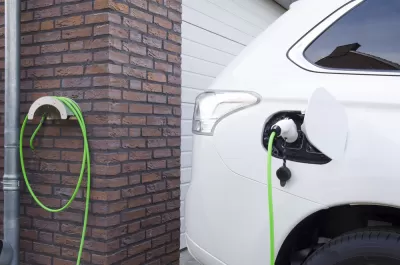Gov. Phil Murphy signed legislation Friday establishing an incentive program for purchasing battery electric vehicles, allowing up to a $5,000 rebate, the nation's highest, plus $500 rebates for home-chargers. EVs are already exempt from sales tax.

"The bill also codifies the Murphy Administration’s goal of 330,000 registered light-duty electric vehicles by 2025 and directs state-owned light-duty vehicles to be electric by 2035," according to the governor's office. However, Tom Johnson, NJ Spotlight's energy and environment writer, explains in the source article that there is more to it.
In the past, New Jersey has fallen behind many other states in the region in the switch to cleaner running cars, which it needs to do after opting to adopt a California program to put more zero-emission cars on its roads.
Under that program, New Jersey needs to put 330,000 electric vehicles on the road by 2025. It rises to 2 million in another 10 years and 85% of all light-duty vehicles by 2040.
"New Jersey was the first state in the country to pass clean cars standards through legislative vote more than 15 years ago, according to Environment New Jersey. The model year 2009 electric vehicles became subject to the California standard, according to the California Air Resources Board [pdf]. Colorado became the tenth state to join the group last summer. However, the program is essentially on life-support due to action taken by the Trump administration in September.
Zero-emission buses and trucks
The legislation directs NJ TRANSIT to purchase all-electric buses by 2032, according to the governor's office, and "directs the Department of Environmental Protection and Board of Public Utilities to establish goals for the electrification of medium and heavy-duty vehicles."
Home charging
The legislation also directs the Board of Public Utilities to establish an incentive program for the purchase and installation of in-home electric vehicle charging equipment up to $500 per person. Both incentive programs will run for 10 years.
Sales tax exemption
While the Garden State may be coming late to the EV rebate program, it has offered a sales tax exemption since 2004. "The incentives could be combined with a current federal tax credit to potentially bring the sticker price of a $40,000 electric vehicle, for example, into the $28,000 range," reports Frank Kummer for The Philadelphia Inquirer on the signing of the landmark legislation.
What about California?
As for competition from the state that began the ZEV program in 1990, the California Air Resources Board reduced the standard rebate for a battery-electric vehicle rebate from $2,500 to $2,000 on December 3 for those consumers who qualify – the state sets a cap on income and also on the sales price of the vehicle. Scroll down to "EV rebates and eligible models decrease" in the December 14 post, "California Climate Program Offers Up to $9,500 Toward Purchase of Used EVs."
Related in Planetizen:
-
New Jersey Power Company Goes Carbon-Free, August 1, 2019,
-
Gubernatorial Elections Have Environmental Consequences, November 13, 2017
Hat tip to Josh Chetwynd, U.S. PIRG.
FULL STORY: Aggressive Program to Electrify NJ Transportation Ready to Launch Today

Study: Maui’s Plan to Convert Vacation Rentals to Long-Term Housing Could Cause Nearly $1 Billion Economic Loss
The plan would reduce visitor accommodation by 25,% resulting in 1,900 jobs lost.

Alabama: Trump Terminates Settlements for Black Communities Harmed By Raw Sewage
Trump deemed the landmark civil rights agreement “illegal DEI and environmental justice policy.”

Why Should We Subsidize Public Transportation?
Many public transit agencies face financial stress due to rising costs, declining fare revenue, and declining subsidies. Transit advocates must provide a strong business case for increasing public transit funding.

Paris Bike Boom Leads to Steep Drop in Air Pollution
The French city’s air quality has improved dramatically in the past 20 years, coinciding with a growth in cycling.

Why Housing Costs More to Build in California Than in Texas
Hard costs like labor and materials combined with ‘soft’ costs such as permitting make building in the San Francisco Bay Area almost three times as costly as in Texas cities.

San Diego County Sees a Rise in Urban Coyotes
San Diego County experiences a rise in urban coyotes, as sightings become prevalent throughout its urban neighbourhoods and surrounding areas.
Urban Design for Planners 1: Software Tools
This six-course series explores essential urban design concepts using open source software and equips planners with the tools they need to participate fully in the urban design process.
Planning for Universal Design
Learn the tools for implementing Universal Design in planning regulations.
Smith Gee Studio
Alamo Area Metropolitan Planning Organization
City of Santa Clarita
Institute for Housing and Urban Development Studies (IHS)
City of Grandview
Harvard GSD Executive Education
Toledo-Lucas County Plan Commissions
Salt Lake City
NYU Wagner Graduate School of Public Service





























